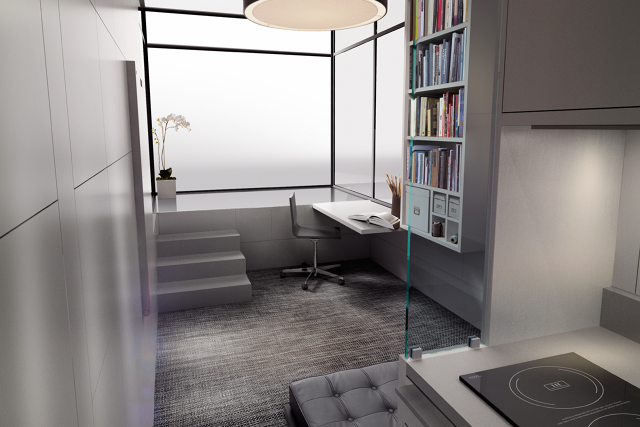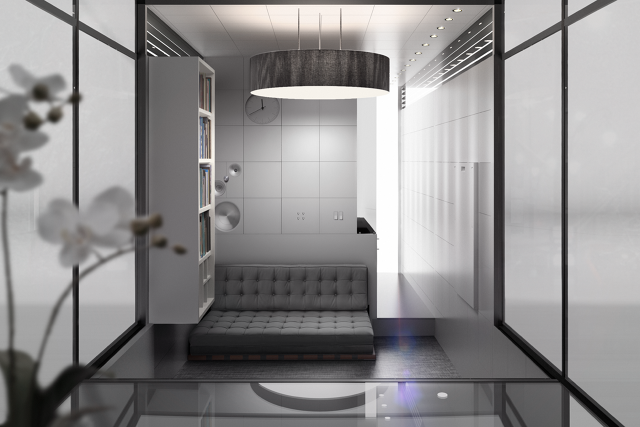moving? you can Take This Tiny, low-cost, good apartment With You anyplace You Go
need to move from San Francisco to Austin? overlook packing and Craigslist. quickly, you’ll be able to open an app and ship all of your situation.
October 6, 2015
if you need to move to a new city, this tiny rental is designed to come with you. What’s even better, it might cost about half the rent of area at market charge, despite the fact that you’re in insanely dear apartment markets like Brooklyn or San Francisco.
The swish glass-and-metal box slides right into a slim steel body that squeezes into otherwise unbuildable a lot in built-up city neighborhoods. if you would like to move, you’d push a button on an app. A shifting truck will pull up, slide the rental completely out of the constructing, and power it to an empty slot in a constructing in different places. forget packing; the whole lot you own can keep inside.

The tech-packed house, known as Kasita, used to be inspired partially through a radical experiment in tiny-home living. For a year, the startup’s founder tried dwelling in a transformed dumpster as a commentary on the excessiveness of the typical single-domestic home.
Ten months in, he used to be quite in poor health of it. however “Professor Dumpster,” aka Jeff Wilson, an environmental science professor on the Huston-Tillotson university, saw a chance to rethink housing—and to design something that was not like any micro-condo or tiny dwelling that had ever existed ahead of.
“I began thinking dwelling in a dumpster—33 sq. toes—and peeing in a bottle is not all that cool, however there are some very interesting things about this. i will move my house anywhere, it can be lovely reasonably priced, I’ve trimmed down my possessions and have less. I was able to eliminate my car, and i reside in one of the best a part of town.”

He began working with an industrial dressmaker from the firm Frog to provide you with a plan that gave an identical advantages. They estimated a form of housing that may be low-rent even in the course of the town, cell, allow for short-term leases, and let individuals keep away from the annoyance of having roommates.
Wilson selected an industrial fashion designer, slightly than an architect, because he wished to keep away from expected solutions.
“I advised him, i would like you to design one thing extra like an iPhone than a micro-rental or a container,” Wilson says. “i would like you to throw out the whole lot about housing—and he did not even be aware of a complete lot—and make one thing in reality iconic.”
the outcome is a bit of like the classic Nakagin tablet Tower in Tokyo—each condo can also be individually moved and replaced. A steel rack bolts collectively in no matter configuration is smart for the lot and local building codes—maybe three tales high.

“It permits us to go into very small areas,” says Wilson. “the entire footprint of that rack is only about 1,000 sq. toes or so. So it lets in us to maneuver into unused, prior to now unusable items of land.”
each and every condominium is about 30% bigger than a shipping container—or the splendid an identical of six dumpsters.
“it is now not just comfortable for a dumpster dweller, but i believe for any single particular person with a cat,” he says. “And/or a goldfish.”
within, there is enough room for things like a washer and dryer and a full kitchen. “it can be a real dwelling,” Wilson says. “have you viewed that Portlandia tiny-home episode? There are no hidden cat litter containers that flip up. I even removed the theory of Murphy beds in lofts. After being in that dumpster for a yr, i wanted a mattress the place that you would be able to just stroll into your home and crash.”
as an alternative of a flip-down mattress, a queen-dimension mattress slides out from under the kitchen. within the wall, modular tiles pull out to permit completely different configurations of merchandise. “it’s essential take a modular tile out of the wall and plug in, say, a clock,” Wilson says. “Or you might want to take out three vertical tiles and plug in a reflect. it’s worthwhile to take out six, and plug in a tv.”

The prefab buildings are additionally absolutely loaded with good tech. which you could tell the glass to darken if you need privateness, turn on the lights and music, or ask for the morning news. though the first gadgets will plug into the grid, the startup envisions ultimately working them off solar power saved in Tesla batteries and including options like rainwater assortment.
regardless of the lengthy listing of options, the dimensions—and the fact that it could possibly go on rather a lot no person else wants—makes it reasonably priced. “we’re very assured that these will employ for about 1/2 of market for a studio,” Wilson says. “So in Austin, that is about $600.”
the company plans to construct its first rack in Austin in the spring of 2016, and has agreements on land in a number of cities. ultimately, it plans to have a community of buildings that individuals can easily move between.
“let’s imagine you are in San Francisco,” Wilson says. “You get on the Kasita app, you to find the rack that you want to move to in Austin, you click move, we come alongside, pull you out of the rack, put you on the truck, move you to Austin, and plug you in. You shouldn’t have to go on Craigslist. the biggest nightmare for a millennial—or anyone who would not have a severely excessive net value—is in search of a spot. We hope to unravel for that.”
[All images: by means of Kasita]
(144)














